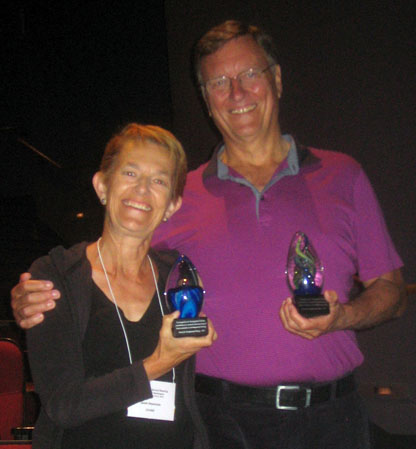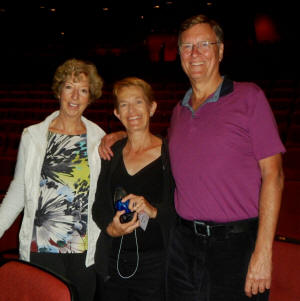Chris Wylie and Janet Heasman
Receive 2014 SDB-Developmental Biology Lifetime
Achievement Award
By Marsha E. Lucas
 The
2014
Developmental Biology-Society for Developmental
Biology Lifetime Achievement Award was given jointly
to
Janet Heasman
and
Chris Wylie for their
outstanding and sustained research and mentoring
contributions to the field of developmental biology.
Together, Wylie and Heasman—now retired from
Cincinnati Children’s Hospital Research
Foundation—made seminal discoveries in axis
formation, primary germ layer formation, and germ
cell development. They showed β-catenin/Wnt
signaling controls the formation of the dorsal axis
in vertebrate embryos; identified VegT as an
essential transcription factor in the formation of
mesendoderm; and identified the mitochondrial cloud
as the source of the germ plasm in Xenopus
oocytes. The pair made a lasting impact on the
Xenopus research community with their development of
the oocyte transfer method which made knocking down
maternally provided gene products possible and then
went on to pioneer the use of morpholino
oligonucleotides for studying zygotic genes. The
2014
Developmental Biology-Society for Developmental
Biology Lifetime Achievement Award was given jointly
to
Janet Heasman
and
Chris Wylie for their
outstanding and sustained research and mentoring
contributions to the field of developmental biology.
Together, Wylie and Heasman—now retired from
Cincinnati Children’s Hospital Research
Foundation—made seminal discoveries in axis
formation, primary germ layer formation, and germ
cell development. They showed β-catenin/Wnt
signaling controls the formation of the dorsal axis
in vertebrate embryos; identified VegT as an
essential transcription factor in the formation of
mesendoderm; and identified the mitochondrial cloud
as the source of the germ plasm in Xenopus
oocytes. The pair made a lasting impact on the
Xenopus research community with their development of
the oocyte transfer method which made knocking down
maternally provided gene products possible and then
went on to pioneer the use of morpholino
oligonucleotides for studying zygotic genes.
Wylie began medical school at the University College
Hospital Medical School in 1963. While there, he did
an intercalated Bachelor’s degree in Anatomy at
University College London (UCL) in 1966. He went on
to earn his doctorate at UCL in 1971 in the lab of
Ruth Bellairs where he studied RNA in the early
chick embryo. Wylie never finished his medical
degree thanks to an offer of a lecturer position at
UCL from the chair of the anatomy department,
J.Z.
Young. In an
interview with Peter Donovan for the
International Journal of Developmental Biology,
Wylie called Young an “inspirational teacher and
scientist.”
In 1971, Heasman began medical school at the
University College Hospital Medical School. Like
Wylie, she made her way to the UCL Anatomy
Department where she earned her Bachelor’s in 1974.
After a year abroad conducting research with Wylie
at Dartmouth College in the United States, Heasman
left medical school to complete her PhD on
primordial germ cells at St. George’s Hospital
Medical College where Wylie had taken a Senior
Lecturer position. In 1979, Heasman finished her
degree and joined the faculty as a Lecturer at St.
George’s.
Wylie and Heasman moved their joint lab to the
University of Cambridge in 1988 where they were one
of the founding labs of what would become the Gurdon
Institute. In 1994, they moved to the University of
Minnesota where Wylie established the Developmental
Biology Center and then again in 2000, to Cincinnati
Children’s Hospital. These later appointments
allowed Wylie to initiate joint basic and clinical
research studies.
Together Wylie and Heasman trained more than 50
students and postdocs throughout their careers while
raising four children. Their fostering of the next
generation of scientists did not end there as they
taught for many years at the Marine Biological
Laboratory Embryology course and the Cold Spring
Harbor Xenopus course which they co-directed from
2005 to 2008.
Wylie was integral in transforming the Journal of
Embryology and Experimental Morphology into
Development in the late 1980’s. As its founder and
editor-in-chief for sixteen years, he made Development the modern journal it is today.
|
 |
|
SDB President (2014-2015), Lee Niswander with
Heasman and Wylie following SDB Awards
Lectures. |
At the SDB Awards Lecture, Wylie noted four key
individuals who were critical in his development as
a scientist. Bill Freeman, his high school rugby
coach and zoology teacher, encouraged him to
consider medical school. This was not on Wylie’s
radar as soccer and rugby were his focus. Freeman
fostered his interest in biology and nudged him
toward medicine. J.Z. Young, the chair of the
anatomy department was an advocate for basic science
and his mentoring led Wylie toward research and a
Ph.D. Ruth Bellairs, his graduate advisor, was an
excellent mentor who worked at the bench along side
her students. Wylie modeled this behavior in his own
lab. Finally, Wylie acknowledged Janet Heasman whom
he met in 1973 and was critical to his success as a
scientist.
In her speech at the Awards Lecture, Heasman said
she loved doing science and teaching. She
particularly enjoyed the evolution of technology
over her long scientific career. Heasman expressed
appreciation for the humans and non-humans that
helped make her career a success. First, she thanked
the mighty Xenopus. The frog embryo provided a
beautiful tool through which she made fundamental
discoveries about basic developmental processes.
Second, she thanked “all the people who made her
research life such a great ride—her colleagues, post
docs, grad students. . . and the unsung
people—secretaries, cleaning ladies, folks at the
grant awarding bodies, etc.” Finally, Heasman
thanked her family who provided a great respite for
the great and not-so-great-days in the lab.
|